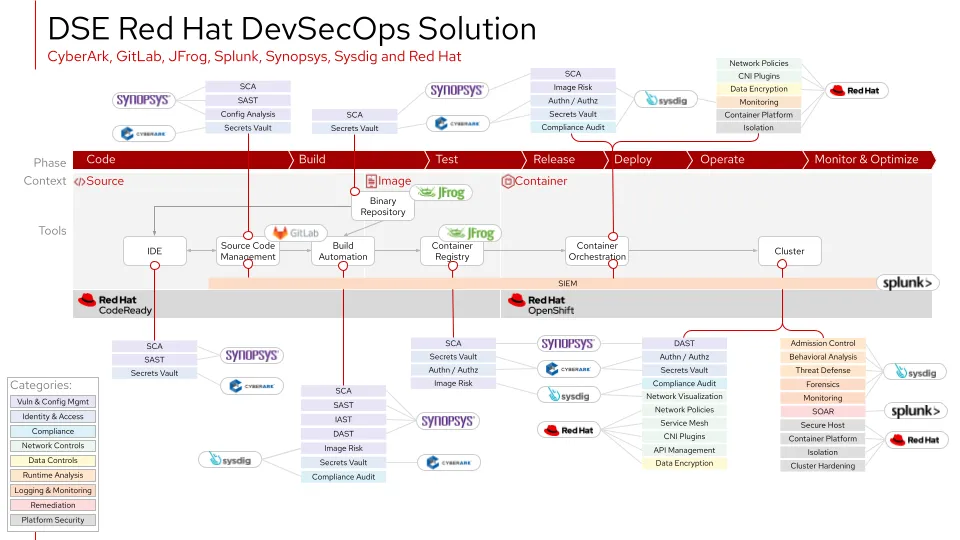Davie Street Enterprises is our fictional Red Hat customer that is working its way through real-world digital transformation problems, and this time around, it's tackling measurement.
Newly-promoted Director of Security Engineering Zachary L. Tureaud knew that Monique Wallace, Davie Street Enterprises’ (DSE) CIO, was impressed with the work he had led on solution design, but he still needed to ensure his DevSecOps vision was working. It wasn’t enough to just point to all the new tooling his team had put together.
He needed to be able to demonstrate, quantifiably, that the changes were having the desired effect. Let’s see how he led DSE toward a DevSecOps practice using measured approaches from Google’s DevOps research and assessment team.
How is DevOps performing at DSE?
In a hallway conversation he had with Susan Chin, Senior Director of Development, and Ranbir Ahuja, Senior Director IT Operations, Tureaud learned that one of the guiding principles they had established was to define and measure goals throughout the DevOps life cycle—exactly what he was looking for.
Borrowing from the four key DevOps metrics Google’s DevOps Research and Assessment (DORA) team had established, Chin and Ahuja have been measuring the team’s performance. They shared their initial findings with Tureaud, prior to when the team - led by Andres Martinez - had guided the development teams into adoption of DevOps:
|
Deployment frequency |
Low |
Quarterly deployments were cause for celebration; anything faster than that was shot down by the CAB |
|
Lead time for changes |
Low |
Heavy backlog filled with high-priority fixes were pushing new feature changes further and further towards the bottom of the priority pile. |
|
Change failure rate |
Low |
The team routinely experienced a high failure rate, primarily due to security issues discovered after deployment. |
|
Time to restore service |
Low |
Don’t even get Wallace started on this one. Spaghettification of code due to the high pressure on the dev team for adding features, and the resulting hypercomplex web of dependencies meant they often would need four to six hours just to identify a root cause. |
The days of sneakernet code transfers—or worse, dealing with Subversion merges—were thankfully in the past after Martinez’s guidance of the adoption of GitLab for continuous integration/continuous delivery (CI/CD) and GitOps. The ephemeral review environments in particular were a major contribution towards improvements in deployment frequency and change lead time.
The streamlined CI/CD process provided them with confidence in their configuration changes and deployments, but also revealed some previously unknown weaknesses. His team had continued to encounter issues related to “dependency creep,” a rather pernicious problem that was caused by too many developers using too many different versions of too many different dependencies.
To solve this, Martinez implemented a repository governance strategy that leveraged JFrog’s Artifactory. Working with Tureaud’s security team ensured that the repositories Martinez’s development teams were using had been vetted and determined to be secure and compliant. It had the added benefit of exposing his developers to packages that some of his teams were using that other teams hadn’t encountered, and they were often much more performant.
The centralized dependency catalog’s caching via Artifactory’s remote repositories took things even further, providing not only for enhanced stability, but also reduced latency, which in turn meant build times were greatly reduced.

Here is the result of the cross-functional team’s DevOps efforts
|
Deployment frequency |
Medium |
On average, the team deployed about every two weeks. |
|
Lead time for changes |
Medium |
Code commit to production occurred every month, on average. |
|
Change failure rate |
Medium |
The team’s failure rate was improved but security issues discovered after deployment were still causing a non-trivial amount of change failures. |
|
Time to restore service |
Medium |
This metric is high on Wallace’s list to improve. The team can only restore service within eight hours, on average. |
Security will only slow us down, right?
Being at DSE before the shift to DevOps, Tureaud knew the stigma security had in slowing development to a crawl. He also knew that one of the reasons he was promoted was due to a couple of projects he led to improve speed through security automation. Tureaud knew he could apply the same principles to improve Chin and Ahuja’s DORA metrics.
Reduce Application security issues discovered in test and production
One of the first metrics Tureaud wanted to tackle was change failure rate because of the amount of security issues discovered after deployment. Using Synopsys and Sysdig, Tureaud implemented security controls in the build to ensure applications were secure before deployment.
Leveraging the work he did with the J.A.R.V.I.S project, Tureaud automated application security scanning into the CI/CD pipeline with Synopsys Intelligent Orchestration facilitating when to run Coverity SAST and Black Duck SCA on each build. One of the build checks Tureaud implemented as a Black Duck policy was to ensure no high or critical vulnerabilities were identified on any dependencies found in the application. This directly lowered the change failure rate as these security issues were found before deployment by the development teams, instead of after by the security team.
Tureaud then used Sysdig’s OpenShift pipeline example to scan the image created in the build process for malware, sensitive content, and ensure they are adhering to DSE’s compliance standards. Scanning the image before it hits the container registry cuts down significantly on registry costs because the build would fail if the image wasn’t safe. Again, this lowered the change failure rate because unsafe images weren’t being deployed to production!
Percentage of deployments stopped due to failed policies
However, if left isolated, these CI/CD gates would actually start to decrease deployment frequency and lead time for changes. Why?
Well, after these gates are enabled, most of the builds would start to fail because the developers don’t have the right tools and knowledge needed to submit secure applications and containers.
Tureaud knew even before he implemented the CI/CD changes, he needed to first shift the security controls left in the development process and hold a series of lunch-and-learns with the development teams on secure coding practices.
One of the key integrations Tureaud implemented for the developers was Synopsys Code Sight, which is an IDE plugin that brought Coverity SAST and Black Duck SCA functionality right to the developer’s desktop. This allowed developers to resolve application security issues before submitting to CI/CD, which would normally break the build due to Tureaud’s new security gates.
Time to fix security issues
The last metric Tureaud had to improve was time to restore service. This was high on Wallace’s list of improvements with the goal of getting to an Elite level (restoring service in less than an hour).
Tureaud’s DevSecOps design seemed to level out at the Medium level with only being able to restore service within 8 hours on average. Tureaud discovered the main challenge in resolving security issues wasn’t the tooling itself, but the ability for the response teams to react and find all the great data within these tools to resolve issues quicker. For example, it typically took the response team 30 minutes to find who owns the affected application, and then another hour or so to do the research and provide all the necessary information to the development teams to apply the fix.
Tureaud turned to Splunk, which has recently partnered with Red Hat to deliver real-time insights across all stages of the application and software delivery life cycle. Splunk has the ability to aggregate and correlate data from Red Hat OpenShift and all the partner technologies in DSE’s DevSecOps architecture.

Now when security incidents occur, information on apps affected, the fixes, and who can apply the fixes is automatically gathered and correlated, allowing the right people to work on the right fixes right away. This significantly reduces the time to resolve security issues down from several hours to an average of one hour.
DSE DevSecOps improves DORA
DevSecOps at DSE wasn’t built in a day, but Chin, Ahuja, and Tureaud’s persistence and great work in improving the team’s DORA’s metrics have materialized into the numbers shown below.
|
Deployment frequency |
High |
The average has now shifted down to once every five days. |
|
Lead time for changes |
Medium |
Code commit to production now occurs every two weeks and is getting better! |
|
Change failure rate |
High |
Hotfixes and rollbacks are very rare at DSE. |
|
Time to restore service |
Elite |
With the comprehensive DevSecOps solution, DSE is able to restore service within an hour. |
The improvement in these four simple metrics provided concrete evidence that the development, operations, and security teams are no longer siloed.
Their collaboration paved the way for improved team and company dynamics. More importantly, these three teams (who rarely worked together) now consider themselves all part of the same cohesive team—building, deploying and maintaining secure applications for Davie Street Enterprises.
Learn more about how Red Hat solutions can help in your enterprise’s DevSecOps journey.
저자 소개
Dave Meurer currently serves as a Principal Solution Architect on the Red Hat Global Partner Security ISV team, where he owns technical relationships and evangelism with security independent software vendor partners of Red Hat. Before joining Red Hat, he spent nine years in the Application Security industry with Synopsys and Black Duck, where he served in similar roles as the director of technical alliances and sales engineering.
Meurer also worked for Skyway Software, HSN.com, and Accenture in various management and application development roles. When he’s not thinking about Kubernetes, security, and partners, he enjoys being the VP Sales of North Central Tampa for his wife (the CEO) and 5 kids (Inside Sales).
유사한 검색 결과
Red Hat to acquire Chatterbox Labs: Frequently Asked Questions
Attestation vs. integrity in a zero-trust world
What Is Product Security? | Compiler
Technically Speaking | Security for the AI supply chain
채널별 검색
오토메이션
기술, 팀, 인프라를 위한 IT 자동화 최신 동향
인공지능
고객이 어디서나 AI 워크로드를 실행할 수 있도록 지원하는 플랫폼 업데이트
오픈 하이브리드 클라우드
하이브리드 클라우드로 더욱 유연한 미래를 구축하는 방법을 알아보세요
보안
환경과 기술 전반에 걸쳐 리스크를 감소하는 방법에 대한 최신 정보
엣지 컴퓨팅
엣지에서의 운영을 단순화하는 플랫폼 업데이트
인프라
세계적으로 인정받은 기업용 Linux 플랫폼에 대한 최신 정보
애플리케이션
복잡한 애플리케이션에 대한 솔루션 더 보기
가상화
온프레미스와 클라우드 환경에서 워크로드를 유연하게 운영하기 위한 엔터프라이즈 가상화의 미래

